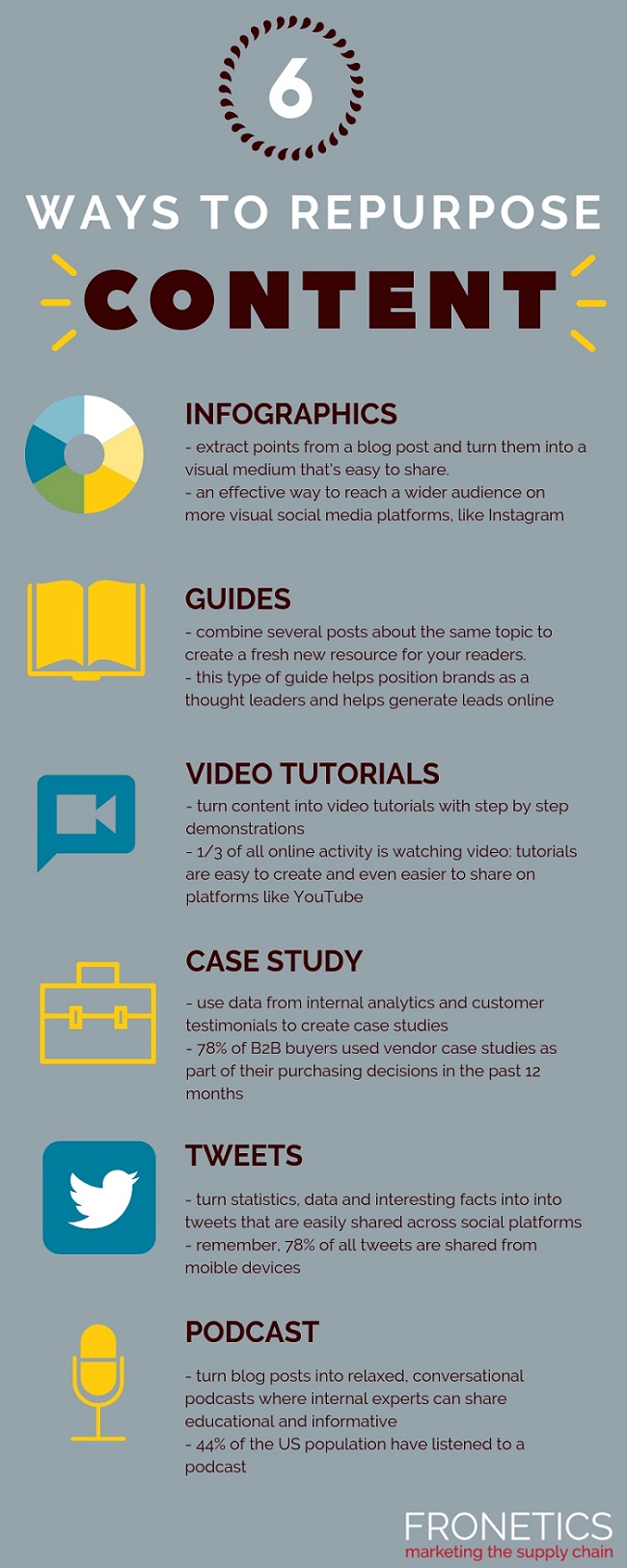
by Fronetics | Dec 11, 2018 | Blog, Content Marketing, Logistics, Marketing, Supply Chain
Our most-viewed content marketing posts indicate that marketers are seeking solutions to improve their content marketing programs.
Supply chain and logistics marketers have seen the benefits (and successes) of content marketing. It is the most cost-effective method to earn leads and sales. Why? Because content marketing focuses on the way B2B byers are making purchases, finding and evaluating content through online searches.
[bctt tweet=”Content marketing focuses on the way B2B byers are making purchases, finding and evaluating content through online searches.” username=”Fronetics”]
There is a trend with our most-viewed content marketing posts this year: innovative ways to improve content marketing strategies. From increasing brand awareness to improving SEO, marketers are looking to get their content in front of the right audiences.
Here’s a look at our top content marketing posts from this past year, all focused on industry trends and ways to improve your content marketing strategy.
Top 10 content marketing posts in 2018
1. B2B Marketing Trend 2018: Influencer Marketing
You’ve probably heard the buzzword by now: Influencer marketing seems to be on the tip of every marketer’s tongue these days. But the reality is that B2B marketers have been slow to adopt this new marketing trend. Influence 2.0 – The Future of Influencer Marketing Research Report 2017 showed that only 11% of B2B marketers have an ongoing influencer program. Read full post
2. Writing for SEO: Topic Clusters and Pillar Content (NOT Keywords)
I’ve been hinting — more like, emphasizing — in our recent Writing for SEO series that trying to rank for certain keywords in each blog post you publish is a practice on the way out. You may have been wondering what you’re supposed to do instead. This post on topic clusters and pillar content is your answer. Read full post
3. 10 Ways to Grow Brand Awareness Quickly
If you took Psychology 101 in school (or even if you didn’t), you know that people are more likely to buy from brand names they’re familiar with than those they don’t know. This goes for purchasing things like medicine, and for procuring components or parts as part of the supply chain. That’s why so many of our clients come to us looking to build brand awareness as one of their main goals. They want to customers to know about them — and sooner rather than later. Read full post
4. Should Your Business Be Using Linkless Backlinks to Increase SEO?
Linkless backlinks are mentions of your business or brand without a hyperlink to your webpage. In a keynote speech in September 2017, Gary Illyes, a webmaster trend analyst for Google, said:
“Basically, if you publish high-quality content that is highly cited on the internet — and I’m not talking about just links, but also mentions on social networks and people talking about your branding — then you are doing great.” Here’s how to make linkless backlinks work for you. Read full post
5. Writing for SEO: People Are Changing How They Search
Last week, we kicked off our Writing for SEO series by taking a look at how search engines are changing. As we delve further into updated strategies for effective SEO writing for supply chain marketers, this post explores the ways in which people are changing their search behaviors, and what that means for your content. Read full post
6. 3 Questions to Ensure your Content Marketing Strategy Is Sales-Focused
I recently read an article on the Harvard Business Review that discussed pairing your sales goals with your marketing goals. This strikes at the heart of what we do at Fronetics: build a client’s content marketing strategy that will help advance their short- and long-term business goals. It sounds simple, but you have no idea how many organizations’ marketing goals are misaligned with what the larger organization is trying to accomplish. Read full post
7. Infographic: 8 Ways to Grow Brand Awareness Fast
Have you ever noticed how some brands seem to have crept into popularity overnight? You’ve never heard of them, and then, all of sudden, they’re everywhere. Their brand awareness has sky rocketed, and they’re achieving every company’s ultimate goal: Customers know about them. So what’s their secret? Read full post
8. The More Often You Publish Blog Content, the More Leads You’ll Get
Here are Fronetics, most of our clients are sales-driven. If a client’s business goals include earning leads, we are sure to align the client’s content strategy with that objective. One of the most effective ways to increase the number of leads your website attracts is to increase the frequency with which you publish content. Read full post
9. How to Identify Topic Clusters for Your Business
One of the best ways to strategically structure your content is with the topic cluster model, in which broad cornerstone content is contained on pillar pages, and related subtopics are contained in cluster content. Each grouping of subtopics and corresponding pillar page is called a topic cluster. This structure is intended to build authority and influence for your business in the eyes of search engines and visitors. Effectively using a topic cluster structure is the best way to drive relevant traffic to your website. Read full post
10. Video: Why Does Content Marketing Take So Dang Long to Show Results?
You are committed to your content marketing program. You’ve created blog posts, uploaded videos, and collaborated with industry leaders. You may have started noticing an increase in web traffic, social reach, and other engagement metrics like time on page. You’re on the right track! The problem is your lack of leads or sales. Your boss is pressuring you for results, and you’re starting to question your efforts. Are you doing something wrong? Read full post
Related posts:


by Fronetics | Dec 10, 2018 | Blog, Content Marketing, Data/Analytics, Logistics, Marketing, Strategy, Supply Chain
Here are our most-viewed blog posts from 2018 about analytics and ROI, including articles about how to calculate your marketing ROI and competitive benchmarking.
Content marketing is increasingly popular in the B2B sector. In fact, 91% of B2B marketers used content marketing as a part of their strategy last year. But marketers still struggle with proving the return on investment.
Evaluating your analytics gives you valuable insight into what’s working (and what’s not) with your content marketing strategy. But 47% of B2B marketers reported not measuring content marketing ROI. And of those marketers, 86% sited lack of knowledge, time, and convenience for reasons why their company doesn’t calculate ROI.
[bctt tweet=”47% of B2B marketers reported not measuring content marketing ROI. And of those marketers, 86% sited lack of knowledge, time, and convenience for reasons why their company doesn’t calculate ROI.” username=”Fronetics”]
This year, Fronetics examined new analytics tools and numerous ways to calculate ROI — within the context of supply chain and logistics operations, as well as how these methods can be used to improve overall marketing performance. Here’s a look at our most viewed analytics and ROI posts in 2018.
Top 5 analytics and ROI posts
1. The Art of Measuring Podcast Success
Podcasts are an increasingly popular content medium, but measuring their performance is difficult. Here are some tips for measuring podcast success in spite of the challenges. Spoiler alert: it’s an art, not a science. Today’s busy professionals are increasingly driven to make their “down time” more productive and engaged. The popularity of podcasts rises every year, with more than 50% of American homes now classified as “podcast fans” by Nielsen. Read full post
2. Top 10 Social Media Analytics Tools
Analyzing your social media performance is critical to a successful marketing effort, especially in light of recent changes to Facebook’s News Feed. You need the tools to determine what’s working and what isn’t, as well as the best time to post your content for your target audience. At Fronetics, we use a variety of tools to measure social media success. Here are our 10 favorite social media analytics tools. Read full post
3. 4 Metrics to Measure the Impact of Content Marketing on Brand Awareness
A successful content marketing strategy strengthens the relationship between brands and their target audiences. And brand awareness is a key component to any successful content marketing strategy. Ultimately, the more aware audiences are of your brand, the more likely they are to buy your products or services. Read full post
4. Use These Metrics to Benchmark Marketing Performance against Your Competitors
Competitive benchmarking is the process of comparing your company’s performance against that of your competitors. You can use various metrics to benchmark what these businesses are doing better than you are and where you have the edge. Benchmarking marketing performance is an important step in the process of evaluating the success of your content marketing strategy. Read full post
5. Infographic: 4 Ways to Measure Blogging ROI
Why do you blog? It seems like a simple question, but the answer has a huge impact on the content you produce and the outcome of your efforts. As with all aspects of your business, you should give the return on investment of your content marketing efforts ample attention. That is especially true for blogging ROI, if generating new business is indeed one of the reasons you blog in the first place. Read full post
Related posts:


by Elizabeth Hines | Dec 6, 2018 | Blog, Content Marketing, Current Events, Logistics, Marketing, Social Media, Strategy, Supply Chain
As content marketing continues to increase in popularity, here are six trends to consider when planning your 2019 strategy.
A recent article by Forbes on content marketing notes: “As recently as a few years ago, marketers handled content mostly as a side project. It was more of a bonus than an essential role — something you did when you had time because it took a backseat to more traditional marketing projects and responsibilities. That’s changed.”
Boy, has that changed. The content marketing industry is expected to be worth more than $400 billion by 2021.
The 2018 report from the Content Marketing Institute shows just how prevalent content marketing is, and how essential it has become to creating brand awareness, educating your audience, and building credibility and trust with your customers.
Supply chain & logistics marketers: Trends to watch
So, where is content marketing headed in 2019? Content marketing budgets are still on the rise, and supply chain and logistics companies are increasingly seeing the value in moving to an inbound marketing strategy driven by original content.
These are the six notable trends to consider when planning your 2019 content marketing strategy.
1. Video
Video is currently the most popular form of content being consumed online today, and video marketing will continue to have substantial value in 2019.
Smart supply chain marketers should start the new year by developing a visual storytelling strategy that offers consistent delivery of valuable content.
What’s your best bet? Be helpful and teach your audience something worthwhile to them.
2. Chatbots
The rise of chatbots – automated computer programs that simulate human conversation in messaging apps – is expected to continue in 2019. Business Insider recently reported that the number of people on messaging apps surpassed the number of users on social networks!
[bctt tweet=”Business Insider recently reported that the number of people on messaging apps surpassed the number of users on social networks!” username=”Fronetics”]
Chatbots are just one of the ways artificial intelligence will shape the content marketing landscape in 2019, but their ability to drastically increase customer engagement puts them on the short list for a major trend to watch in the coming year.
3. Voice search
Voice search is becoming an increasingly prevalent means of attaining information. Statistics vary, but it’s expected that anywhere between 30-50% of all searches will be voice searches by 2020. A recent report by NPR and Edison Research found that the rise of smart speakers is substantially changing consumer routines and purchasing behavior.
A good content marketing strategy for 2019 should consider how your customers might use voice search in your industry, and what you can do to maximize your content’s ability to respond.
4. Long-form content
I love this one, because it harkens back to humble beginnings of content marketing and the desire to put informative, quality content in front of a targeted interested audience.
Long form content – white papers, case studies, and lengthier blog posts e.g. – will have a resurgence of renewed appreciation in 2019. Why? Because many industries, including supply chain and logistics industries, are saturated with tons of mediocre short form content. People are increasingly looking to weed through it all for substantial quality posts from trusted sources. In addition, search engines will favor longer posts in results rankings.
Cheers to 2019 being the year of quality over quantity!
5. Brand ambassadors
We wrote about brand ambassadors as we headed into 2018, but they are worth mentioning again as we look forward to 2019. Brand ambassadors are employees that influence the B2B buying decisions of others, and they are an often-overlooked resource with more traditional marketing tactics.
Peers and colleagues are the third most influential source of information for business to business (B2B) purchasing, right behind online searches and your website! And there’s nothing more credible than a friend who speaks highly of their company’s product or service.
Definitely consider how you can help make brand ambassadors out of your employees in 2019.
6. Market Influencers
The final trend to watch in 2019 is influencer marketing, a form of marketing which focuses on influential people rather than the market as a whole.
Basically, marketers identify individuals who might have influence over potential buyers and create marketing campaigns and activities around these influencers. In many ways, this works similarly to a brand ambassador, where a single person influences their network of friends; in this case, however, the market influencer has a large network and a lot of “friends” who listen.
Influencer marketing will be a huge trend in marketing for 2019, and it would be worth considering who might be an influencer in your industry in the coming year and what your company might do reach them.
So, there you have it. As we head into 2019, these are the trends to watch and plan for in content marketing space.
The B2B buying climate is growing longer and more complex, and content marketing is so effective throughout the entire sales cycle if it’s done well. The end of the year is a great time to revisit your marketing strategy and make any necessary changes for the coming year.
Best wishes in the year ahead!
This post originally appeared on EBN Online.
Related posts:


by Fronetics | Dec 5, 2018 | Blog, Content Marketing, Logistics, Marketing, Supply Chain
Content marketing is reshaping the sales process. Here’s what this strategic resource can do for you.
We’ve said it before, and we’ll probably say it again: content marketing is not about making a sales pitch. Nor is it a substitute or replacement for an expert sales staff. However, with the right strategy, and with a closely aligned sales and marketing team, this inbound approach to marketing can revolutionize the way supply chain businesses approach sales.
There’s no question that content marketing has changed the sales process. Thanks to the content and resources available to them, potential customers are more informed as they enter the buyer’s journey. Content marketing helps generate a steady flow of quality leads and provides targeted information to usher prospects down the sales funnel.
[bctt tweet=”Content marketing helps generate a steady flow of quality leads and provides targeted information to usher prospects down the sales funnel.” username=”Fronetics”]
In this new environment, marketing and sales need to work in tandem to be at their most effective. This way they can help each other generate leads, nurture current leads more effectively, and close more deals. Here are three important ways content marketing is changing the way businesses accomplish these goals:
1) Inbound over outbound
Old school marketing was all about outbound — a marketing approach that pushes a message onto a buyer. Traditional advertising — tv and radio ads, telemarketing, banner and display ads — are all examples of outbound marketing. Content marketing takes the opposite approach: inbound marketing.
Inbound marketing focuses on audiences finding you. Instead of pushing a message onto buyers, inbound marketing allows you to establish your brand as an industry leader and let interested audiences come to you. This type of marketing attempts to draw in potential customers through interesting and engaging content.
When it comes to sales, inbound marketing is a game-changer. Content marketing is all about creating a relationship with prospects and paving the way for the sales team to nurture and develop that relationship. Your sales staff is empowered to nurture more leads through to conversion when they are armed with effective, targeted content.
2) Providing information
Once your prospect is ushered into the sales funnel, content marketing can help your sales team continue the conversation. The content you share with prospects at this stage of the buyer’s journey should be designed to answer informed questions and demonstrate that your products and services are there to meet their needs.
Quality content is your sales staff’s best friend. As sales personnel answer questions from prospects and help guide them toward conversion, email, blog, and other types of content are key to keeping prospects interested and moving them down the funnel.
3) Cultivate loyalty
Converting leads is important, but it’s only half the battle. Cultivating loyal customers for your business is crucial to success. Content marketing can not only help you do this, but it can turn those loyal customers into ambassadors for your brand.
Your sales staff should use the high-quality content and guidance provided by your marketing team to engage with satisfied customers on social channels like Facebook, Instagram, and Twitter. Rather than trying to push products, they can use these social spaces to share expert information and foster conversations that will lead other prospects to your business.
Content marketing and sales are a match made in heaven. Curating and creating great content will generate quality leads for your company. It also empowers your sales force to build relationships with potential customers — and close the sale.
Related posts:


by Fronetics | Dec 4, 2018 | Blog, Content Marketing, Logistics, Marketing, Strategy, Supply Chain
Repurposing content is an efficient way to reach a broader audience and build brand awareness.
You spent hours pouring over stats and interesting facts for a blog post. Don’t let all of that effort fall to the wayside. Breathe new life — and reach new audiences — by repurposing that content into engaging new formats.
Some social users like video, while others prefer pictures or podcasts. Taking content and changing its original format is just smart business. Repurposing high-quality content saves marketers time and money and helps to reach a broader audience.
Be picky
Not all of your blog posts and content get the same attention, and that’s ok. Some pieces will resonate more, increasing engagement and driving website traffic.
Run analytics on your content and see what pieces have performed the best. Use tools like Google Analytics to determine your most popular blog posts, your most engaged tweets, or your most viewed videos. This data will help you decide which content should be repurposed. The idea is to take one piece of content and gain visibility and expand your audience by turning it into multiple pieces of content.
The Rule of 7
Repurposing content isn’t just about cutting and pasting content. Have you heard of the Rule of 7? The Rule of 7 is a marketing principle that states your prospects need to encounter your content seven times before they take notice. That’s right, seven times.
[bctt tweet=”The Rule of 7 is a marketing principle that states your prospects need to encounter your content seven times before they take notice. That’s right, seven times.” username=”Fronetics”]
Repurposing content is a great way to take high-quality content and continue to get it in front of audiences without seeming redundant. HubSpot reports that brands who blog around 16 times or more per month get 3.5 times more traffic and 4.5 times more leads than businesses that blog fewer than four times a month. Frequency clearly gets results, but it can also be incredibly time-consuming to create new content 16 times every month. Repurposed content can help your marketing team increase frequency while focusing on quality.
Infographic: 6 ways to repurpose content

(Made with Canva)
Takeaway
How much value does your company put on content? It may be even more important than you think. Use these tips to repurpose high-quality content or yet better, start creating content with these tips in mind. Thinking about a topic and how you can turn that topic into multiple pieces of content will help your hard work go further and perform better.
Related posts:


by Fronetics | Dec 3, 2018 | Blog, Content Marketing, Logistics, Marketing, Social Media, Supply Chain
Social media is a valuable tool for businesses, but only if they use it to their best advantage and avoid these three common mistakes.
81% of small and medium businesses use a social platform. And we all understand why. By 2019, it is estimated that there will be around 2.77 billion social media users around the globe. That’s a lot of potential customers.
[bctt tweet=”There’s no disputing social media is an effective way to increase brand awareness and generate leads. But it can be fairly useless if your company isn’t doing it right.” username=”Fronetics”]
So, there’s no question as to why companies are jumping on the social media bandwagon. And there’s no disputing social media is an effective way to increase brand awareness and generate leads. But it can be fairly useless if your company isn’t doing it right.
Top three social media mistakes companies make
Mistake #1: Using objectives instead of strategy
Social media platforms are continually making changes and updates to improve the user experience. In order to weather these changes and keep your audience engaged, it’s imperative to have a clear strategy that includes types of content, frequency, and pillar topics.. Posts should reflect your brand, so make sure posts follow style guidelines and reflect your specific tone.
A strategy will also help prove ROI. Social Media Examiner’s 2018 Social Media Marketing Industry Report found that only 44% of marketers agree that they know how to measure social media ROI. That means two-thirds of marketers don’t know whether or how much their marketing efforts are paying off when it comes to the use of social media. A strategy that incorporates defined goals, tracking and measuring will help prove data-driven ROI and improve your social media presence.
Mistake #2: Using the most popular social media platforms
Not all social media platforms are created equal. In fact, all social media channels have a differentiating quality that makes them appealing to specific audiences. Start by identifying where your target audience is spending their time. For example, 81% of millennials view their Twitter account on a daily basis. If your company is looking to capture millennials as leads, your social media efforts should certainly include Twitter.
Once you’ve determined where you should be posting, concentrate on creating content that caters to those specific platforms. Lots of companies post the same content across all of the apps they use. We understand how easy that is for marketers, especially with automation tools. But the foundation of social engagement is authenticity, something that is hard to achieve when posts are the same across all channels. Work to create content — including video and images — that caters to specific platforms to build brand awareness and loyalty.
Mistake #3: Promoting instead of connecting
Social media is all about engagement. Users don’t want to engage with brands that are pushing their products and services. Users want informative, interesting, and yes, even fun content. Companies need to focus on creating content that leaves their users wanting more.
Companies that are succeeding on social media are finding innovative and creative ways to relate to users. When you engage and get users involved in your story, you create long-lasting customer relationships. Storytelling creates an emotional bond with your company and drives brand loyalty.
Greg Hadden, executive creative director of Motive Made Studios, sums up the power of connecting with users: “What often gets lost is the fact that good storytelling is potent stuff. It has the power to make people want to believe and to belong, which is the goal of all storytellers. We’re all selling something, be it an idea, an exploration of the human condition, or say, a vacuum cleaner. It’s no mistake perhaps that good stories often create products.”
Final thoughts
Social media platforms are a powerful resource that can help your business grow. But they have to be used correctly. Creating a documented strategy will help shape your brand’s social media presence and give you milestones to test and tweak your progress. Need help creating a social media strategy? Let us help.
Related posts:












